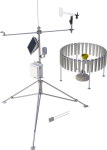我们做什么
Campbell Scientific instruments are used in a wide variety of environmental-research applications. Our data loggers are compatible with most sensors, and commonly measure meteorologic, hydrologic, and soil conditions. Data are often used in research facilities and applications evaluating relationships between different organisms as climate and other conditions change. Campbell soil sensor products are key to agricultural research, irrigation scheduling, forestry, watershed studies, leak detection, slope stability, and many other disciplines.
了解更多有关更多详细信息我们 环境研究 系统
Data Loggers
At the core of our systems is a programmable data logger that measures the sensors, then processes, stores, and transmits the data. These data loggers have programmable execution intervals, wide operating temperature ranges, and on-board instructions for commonly used sensors. If needed, channel capacity can be expanded using multiplexers.
Data are typically displayed and stored in the units of your choice (e.g., wind speed in mph, m/s, knots). Measurement processing and data storage are programmable, but measurements are typically made every minute then processed and stored at hourly and daily intervals (e.g., maximum, minimum, average). Data can be measured and stored more or less frequently (depending on the application and conditional sampling) based on events such as increased wind speeds, torrential rainfall, or diurnal cycle.
Battery power and solar power allow our data loggers to provide remote, unattended data collection over long periods of time. Our instrumentation has been proven in some of the harshest environments in the world.
PC-based software is customized to simplify data logger programming, data retrieval, and report generation. The data logger program can be modified at any time to accommodate different sensor configurations or data processing requirements.
Sensors
Almost any sensor can be measured by our data loggers, allowing monitoring systems to be customized for each site. Typical sensors used on our stations include, but are not limited to: wind speed, wind direction, solar radiation of various types, air temperature, water temperature, soil temperature, relative humidity, precipitation, snow depth, barometric pressure, soil moisture, soil electrical conductivity, and soil heat flux. Our systems interface to a variety of sensors that measure water level and water flow, as well as water quality parameters such as pH, conductivity, and dissolved oxygen. Our data loggers can interface directly to most air flow sensors, opacity meters, particle samplers, and gas analyzers.
Communications
We offer multiple communications options for data retrieval, allowing monitoring systems to meet specific application requirements. On-site data retrieval options include storage module, laptop computer, PDA, and data logger keyboard/display. Telecommunication options include short-haul, voice synthesized telephone, cellular telephone, radio frequency, multidrop, and satellite. Options can be mixed within the same network. Robust error-checking and low power-use ensure your data arrives uncorrupted and as scheduled. You can even automate the process of putting your data on the Internet.
案例研究
CS110 Electric Field Meter to Recreate the Carnegie Curve of Earth's Fair-Weather Electric Potential Gradient INESC......阅读更多
The Warra long-term ecological research (LTER) site located in Southwestern Tasmania was founded in 1995......阅读更多
The Hubbard Brook Experimental Forest (HBEF), located in the White Mountain National Forest of central......阅读更多
Washington State University’s AgWeatherNet (AWN) is a large automated network composed almost entirely of Campbell......阅读更多
A long-term scientific study to monitor trends in the biodiversity and structure of ecosystems of......阅读更多
The Delaware Environmental Observing System (DEOS) is a real-time system dedicated to monitoring environmental conditions......阅读更多
The Charles Sturt University (CSU) Rhizolysimeter is one of the largest root-growth research facilities in......阅读更多

















